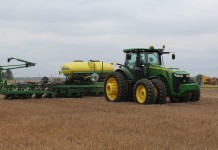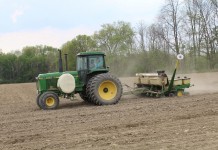URBANA, Ill. — Assuming that the majority of the corn crop gets planted before the middle of May, prospects for a 2008 average U.S. yield at or above trend will be maintained, said a University of Illinois Extension marketing specialist.
“The question is whether trend yield will be sufficient,” said Darrel Good. “An estimate of actual planted acres will not be available until June 30.
“In addition, even with timely planting, yields are still mostly dependent on summer weather conditions.”
Good’s comments came as he reviewed corn production prospects, which he termed “uncertain.”
Spring rally
The USDA’s Prospective Plantings report, released March 31, provided much of the fuel for the spring rally in corn prices. Corn producers reported intentions to plant only 86.014 million acres of corn, nearly 7.6 million fewer acres than planted in 2007.
Intentions were well below expectations and well below the magnitude of acreage needed to allow corn consumption to continue at the current rate of 13.11 billion bushels per year.
“It may be that the size of the market for U.S. corn will not grow during the 2008-2009 marketing year even without further price increases,” said Good.
“There is some evidence, for example, that hog producers are reducing the size of the breeding herd, pointing to a decline in the number of hogs to be fed in 2009.”
Exports
Exports of U.S. corn may decline modestly from the record level being experienced this year if world wheat production rebounds and if the U.S. dollar strengthens, he said.
The size of the Chinese corn crop and subsequent trade policies, however, will also be important for U.S. corn export demand.
Good noted that ethanol demand for corn is also a little more uncertain as policymakers debate proposals to reduce the level of biofuels production mandates and the magnitude of the blender’s tax credit.
“Changing the level of mandates, however, would likely have very little short-term impact on the demand for corn to produce ethanol if the economics of production remains favorable,” he said.
“The level of the tax credit has a more direct impact on the returns to ethanol production. At current prices for corn and ethanol, however, corn-based ethanol production would remain profitable even with a modestly lower blender’s tax credit.”
Projections
The USDA’s World Agricultural Outlook Board will release the first supply, demand and price projections for the 2008-2009 U.S. corn marketing year May 9.
“The smaller projection will be, in part, forced by a production forecast constrained by intended plantings and trend yield,” said Good.
“The potential size of the corn market at current price levels is extremely important in evaluating the size of the 2008, U.S. corn crop needed to avoid rationing of use by higher prices.”
If, for example, market size is seen as 13 billion bushels, the 2008 crop needs to be at least 12.7 billion bushels to maintain year-ending stocks at or above one billion bushels, Good said. If 86.014 million acres of corn are planted, harvested acreage for grain would likely be near 79 million acres under average weather conditions.
Therefore, he added, a crop of 12.7 billion bushels would require a national average corn yield of 160.8 bushels, nearly 10 bushels above the 2007 average.
“Even with a potential market for only 12.5 billion bushels, the U.S. crop would need to be near 12.2 bushels, requiring a national average yield of about 154.4 bushels per acre to maintain year-ending stocks at one billion bushels,” he said.
Chance
There is some possibility that planted acreage of corn will exceed intentions reported in March. The market will monitor the USDA’s weekly report of planting progress to evaluate both the likely magnitude of planted acreage and average yield potential.
“Rapid planting would favor an increase in acreage and at least a trend yield,” he said. “Planting progress in April was generally very slow, with only 10 percent of the crop planted as of April 27, compared to 20 percent last year and the five-year average of 35 percent.”
Rapid planting during the first two weeks of May would still support expectations for more planted acreage and expectations for at least a trend yield in 2008.
Even with a slower rate of planting than expected, corn prices stabilized recently.
Window
“There is a general perception that, given a window of opportunity, producers can now plant the crop more rapidly than in the past,” said Good.
“While modern planting systems clearly allow individual producers to plant more acres per day, there is no clear evidence that in aggregate the corn crop actually gets planted more rapidly in recent years than three or four decades ago.”












